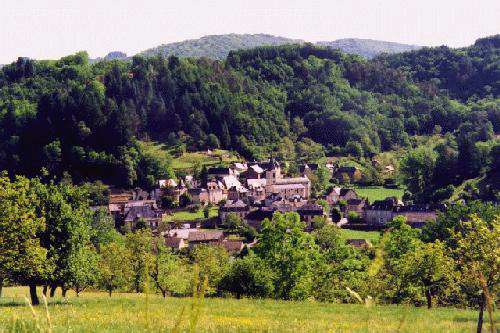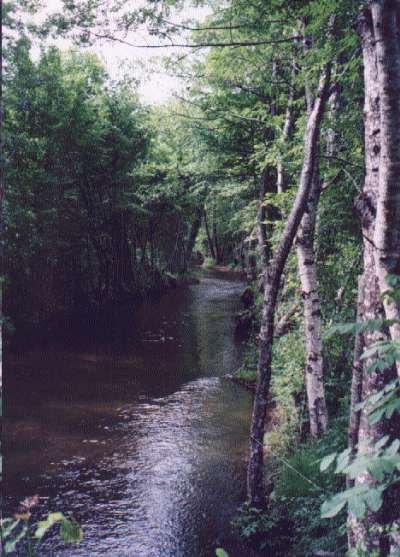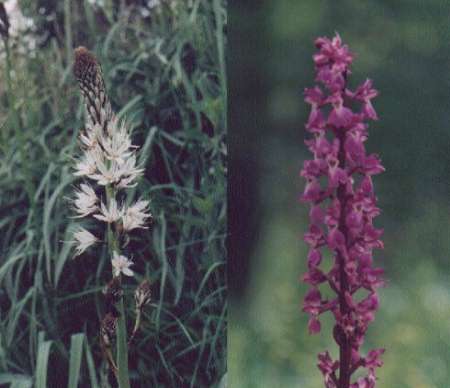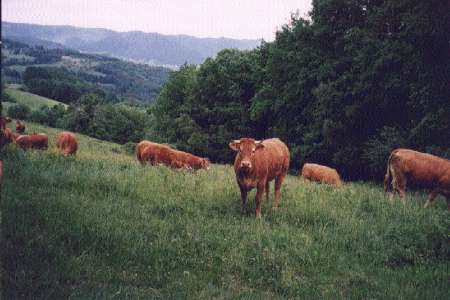«Forgès and its surroundings»

Forgès is a small village in the Corrèze about 10 miles south of the "county town" of Tulle. The Corrèze, administratively part of the Limousin (the area around Limoges), is bordered by the departments (counties) of the Haute Vienne and Creuse (both also in the Limousin) to the north. The Puy-de-Dome and Cantal (both in the Auvergne) lie to our east, while in the south and west respectively, we touch the Lot (part of Midi Pyrenees region) and the Dordogne (part of Aquitaine).
To visit Forgès' web site, click here

In some respects, the Corrèze reflects the wide diversity of our neighbours. To the south and west of the county, we have both limestone plateaux and low lying alluvial valleys. The Brive basin grows wonderful spring vegetables and fruit, while Beaulieu does much to justify its claim to being the strawberry capital of Europe. On the plateaux, herds of goats and vines compete above limestone caves, used by earliest man in prehistorical times.
The Gouffre de Padirac and Rocamadour lie only some 40 miles to the south-west of us in the Lot.
To the north and east, we have the great granite plateau of Millevaches and also the Monédières massif. For those of you who speak French, you might think that Millevaches implies great herds of cattle, but the word "vache" is a dialect name for "spring" and the name refers to the peat bogland which is found there. In fact the Plateau is one of the most important European wetland conservation areas. These 2500 ft mountains lead the traveller up towards the (extinct) volcanoes of the Auvergne, and are a riot of wild flowers in spring and early summer. Lovers of peace and quiet will appreciate that at 2 persons per square km, it has one of the lowest population densities in Europe.
Slightly to the south of Millevaches, some of France's greatest dams generate electricity for the region from the melt water of the Cantal captured in the Dordogne river, before it tumbles down to Argentat and calms down to become the artery of this whole area of France. One of these, the dam of Bort-les-Orgues, has created a great lake, and in the middle if it, the Château de Val is quite gorgeous. Nearby, the Orgues, strange hexagonal rocky outcroppings, remind Mendelssohn lovers and British visitors of the Giant's causeway and Fingals cave. That whole area, with the gorges of the Dordogne make a very agreeable and easy day trip by car from here.
To the south-east, the roads lead through the area known as the Xaintrie, and this again acts as something of a preamble to Aurillac and the skiable terrain of the Plomb du Cantal. High (2000 feet or so) and granitic, the gray stone villages can appear a little daunting at first, but a little effort reveals a charming countryside, with a shy but friendly people, less outgoing perhaps than their valley-dwelling neighbours, but hugely generous when you get to know them and it is there, in the heart of the Xaintrie that we hide a real delight, the Tours de Merle.

This wide diversity of terrains - from limestone plateaux, via river alluvium to granite mountains, means that we have an enormously wide diversity of flora and fauna - not to mention the mushrooms for which the Corrèze is justly famed. The Souvigne is a trout stream - and the Dordogne itself is one of the best rivers for fishing both trout and grayling among other species.
Within the communal area of Forgès, there are the "Cascades de Murel" which form the focal point of one of the marked and cleared walks that have been created in the area. These falls are formed as the stream, the "Franche Valeine" tumbles over the edge of the high ground on which the neighbouring villages of Albussac and Neuville sit. On the same plateau, the Roche de Vic is a good view point to see the surrounding countryside. When visibility is good there, the volcanoes of the Auverge are clearly visible, as is the Plomb du Cantal some 70 miles to our south-east. There is an orientation table on top of the Roche de Vic as well as a shrine to our Lady, which is the site of pilgrimage at the time of the Feast of the Assumption. Apart from these two, there is supposed to a site of a Roman Oppidum as well, but we've never managed to find it!

All in all, this is one of the few remaining unspoilt regions of western Europe. However, economic pressures are forcing change to farming methods, and it is by no means clear that the pleasant land that we know now will resist indefinitely. The great danger facing almost the whole of the Limousin is that of what the French call - somewhat barbarically "desertification" - the urban drift towards jobs, and away from the countryside. If we don't have many small farmers left because small farms can't compete in world markets, then we'll have no-one to tend the land, which will revert to scrub and wilderness. The land simply isn't suitable to be adapted to the sort of large scale agribusiness that has so disfigured large tracts of Europe, so at least we'll be spared that.

Yes, it is rural isn't it! A field in the hills just above Forgès. Curious and friendly Limousin cattle browse knee deep in mixed grassland in the hills just above Forgès. In the distance, you can see the hills on the other side of the valley. Could it be that one of the reasons that beef and veal tastes so good here, is that the bulls are usually kept in the same field as the rest of the herd? Certainly it makes for gentle animals and appeals to some romantic anthropomorphism!

